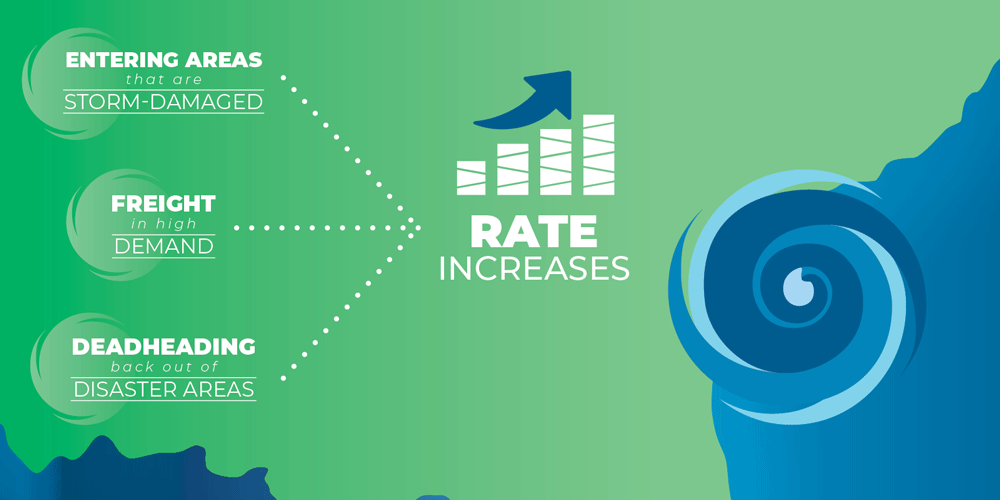Supply chain disruptions are nothing new to us — especially in a time when everyone is trying to recover from the impacts of the COVID-19 pandemic. While there are signs we’re on the road to recovery, we’re now in a weather season that can have major impacts on the supply chain. Here are some things to consider as you plan your shipping needs during hurricane season.
Whether or not your facilities are located within a geographical area directly impacted by hurricanes, the storms most certainly impact you as a shipper. When weather strikes, recovery and relief supplies are needed within the impacted area as soon as possible. This oftentimes causes an unanticipated shift in truck capacity, limiting availability and impacting rates because of the following reason, among others:
- Carrier capacity will respond to network shifts based on crisis needs.
- Entering the impacted areas comes with risk, which also leads to higher rates.
- Outbound freight opportunities from the affected areas is limited since many manufacturers tend to shut down following a storm, leading to increased rates to cover the empty miles between loads.
- Resources are limited for offloading of supplies, yet the volume of products being shipped in is increased. That leads to increased detention and layovers, which adds a premium to the original rates to make up for time spent waiting.

The best way to minimize the impact to your supply chain during a potentially tumultuous hurricane season is to be proactive. Have flexibility with transportation providers and your delivery schedules, if possible. Seek out partners with scalable fleets and widespread geographic coverage who can adapt quickly to changing market demands. Another thing that can help you be a better shipper this hurricane season is talking to your transportation provider now about what your needs will be over the next several months. Help them prepare to help you.
Another best practice would be getting your inventories moved to a closer facility now, if possible. That holds especially true if your regular storage facilities are in hurricane-prone areas. That way if — or when — a hurricane strikes, your products will be closer to their final destination — and potentially out of an impacted area.
What’s Different about This Hurricane Season
This hurricane season likely won’t be like others we’ve dealt with in the past. While COVID-19’s impact on the supply chain is slowly fading, it will almost certainly affect hurricane relief efforts. Typically, there’s an immediate spike in trucks needed for supplies and it fades fairly quickly after enough materials are delivered. However, with social distancing still being practiced by many, there may be a lack of volunteers willing to go into disaster areas. That, in turn, could elongate the recovery process.
That means the demand for post-disaster capacity may drag out longer than you’re used to seeing, which could lead to two potential outcomes. Carriers may support the relief efforts for a longer period of time to maximize their opportunities in the premium rate environment — or they won’t take freight into the impacted areas at all because the rates won’t spike as much as they typically do during hurricane relief efforts. No matter how things turn out, it’s best to be prepared as if you won’t have access to the capacity you’re used to having this time of year.
Good transportation companies anticipate and prepare for potential supply chain disruptions. Whether or not those disruptions come to fruition, those companies have plans in place to mobilize, shift and/or get capacity where it’s needed — even if random disruptions, like COVID-19, arise. If you’re not already doing so, I highly encourage you to include this type of planning in your business model. Reach out to us. We’d be happy to help.




